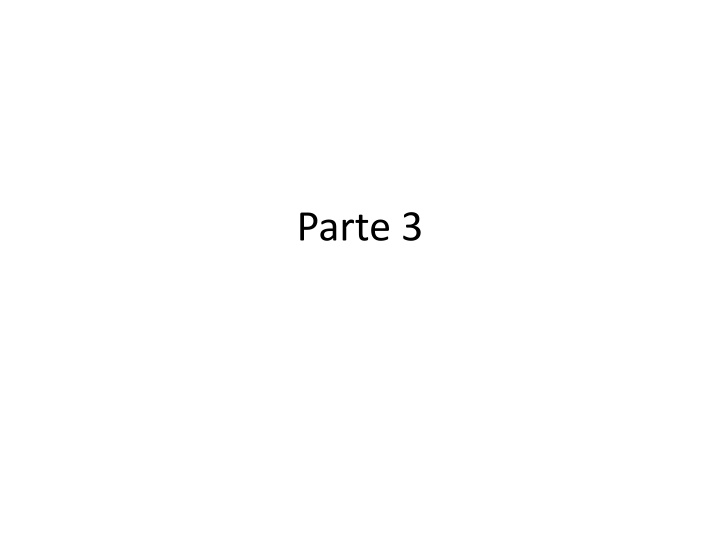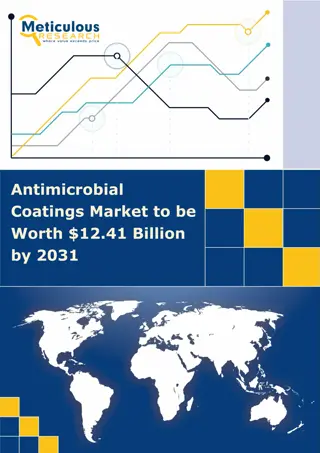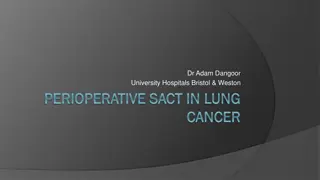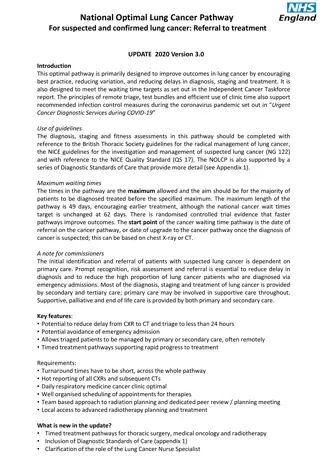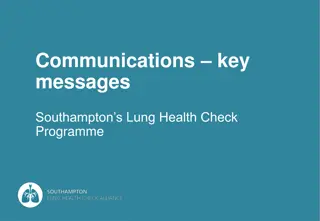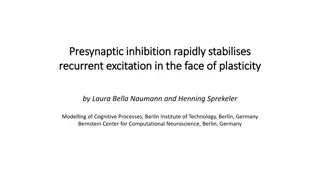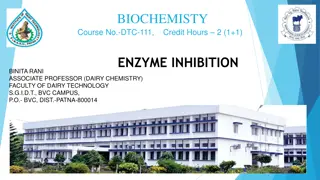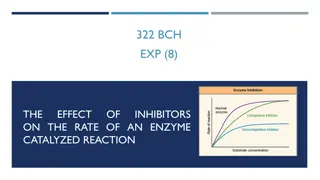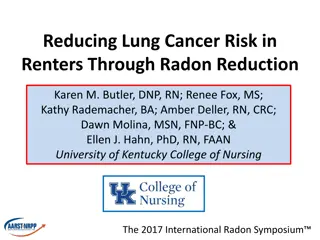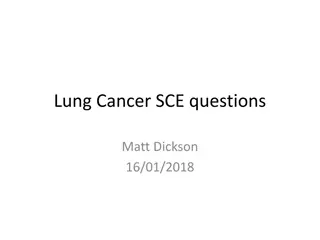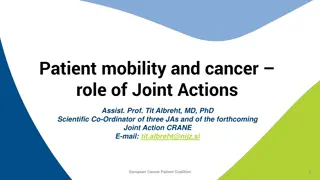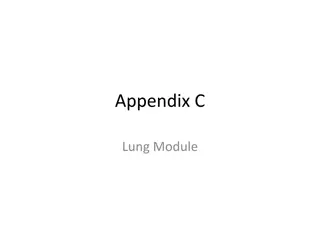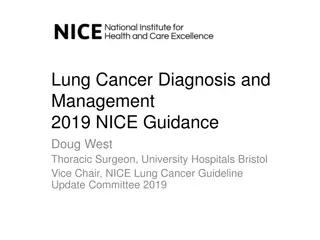Inhibition of TNKS for Lung Cancer Growth Reduction
This study proposes inhibiting TNKS1 and TNKS2 as a potential strategy to reduce lung cancer proliferation. The research explores the impact of pharmacological or genetic inhibition of TNKS on lung cancer growth. It emphasizes the need for new approaches in treating or preventing lung cancer. The findings suggest promising implications for inhibiting TNKS in combating lung cancer.
Uploaded on Oct 01, 2024 | 0 Views
Download Presentation

Please find below an Image/Link to download the presentation.
The content on the website is provided AS IS for your information and personal use only. It may not be sold, licensed, or shared on other websites without obtaining consent from the author.If you encounter any issues during the download, it is possible that the publisher has removed the file from their server.
You are allowed to download the files provided on this website for personal or commercial use, subject to the condition that they are used lawfully. All files are the property of their respective owners.
The content on the website is provided AS IS for your information and personal use only. It may not be sold, licensed, or shared on other websites without obtaining consent from the author.
E N D
Presentation Transcript
Coverage and Staffing Plan structure Manuscript Linking your ideas Introduction New ways to treat or prevent lung cancer are therefore needed. Problem This study explored the hypothesis that inhibition of TNKS would inhibit lung cancer growth Objectives Discussion Pharmacological or genetic inhibition of TNKS1 and TNKS2 reduces lung cancer proliferation... Conclusion Busch et al. BMC Cancer. 2012;13:211.
Download at: http://www.edanzediting.com/sa2015 Section 4 Titles and abstracts
Customer Service Titles and abstracts Effective titles Important points Avoid Summarize key finding Contains keywords Less than 20 words Questions Abbreviations New or novel El t tulo debe ser conciso y resumir los hallazgos m s relevantes Your title should be a concise summary of your most important finding
Customer Service Titles and abstracts Abstract El compendio es la secci n m s importante del art culo Relevance of your aims Importance of your results Validity of your conclusions First impression of your paper Judge your writing style Probably only part that will be read
Customer Service Titles and abstracts Sections of an abstract Concise summary of your research Background Why the study was done Aims Your hypothesis Methods El compendio debe tener sentido por s mismo Techniques Results Most important findings Conclusion Conclusion/implications
Customer Service Titles and abstracts Unstructured abstract Our understanding of the mechanisms by which ducts and lobules develop is derived from model organisms and three-dimensional (3D) cell culture models wherein mammalian epithelial cells undergo morphogenesis to form multicellular spheres with a hollow central lumen. However, the mechanophysical properties associated with epithelial morphogenesis are poorly understood. We performed multidimensional live-cell imaging analysis to track the morphogenetic process starting from a single cell to the development of a multicellular, spherical structure composed of polarized epithelial cells surrounding a hollow lumen. We report that in addition to actively maintaining apicobasal polarity, the structures underwent rotational motions at rates of 15 20 m/h and the structures rotated 360 every 4 h during the early phase of morphogenesis. Rotational motion was independent of the cell cycle, but was blocked by loss of the epithelial polarity proteins Scribble or Pard3, or by inhibition of dynein-based microtubule motors. Interestingly, none of the structures derived from human cancer underwent rotational motion. We found a direct relationship between rotational motion and assembly of endogenous basement membrane matrix around the 3D structures, and that structures that failed to rotate were defective in weaving exogenous laminin matrix. Dissolution of basement membrane around mature, nonrotating acini restored rotational movement and the ability to assemble exogenous laminin. Thus, coordinated rotational movement is a unique mechanophysical process observed during normal 3D morphogenesis that regulates laminin matrix assembly and is lost in cancer-derived epithelial cells. Wang et al. PNAS. 2013; 110: 163 168.
Customer Service Titles and abstracts Unstructured abstract Our understanding of the mechanisms by which ducts and lobules develop is derived from model organisms and three-dimensional (3D) cell culture models wherein mammalian epithelial cells undergo morphogenesis to form multicellular spheres with a hollow central lumen. However, the mechanophysical properties associated with epithelial morphogenesis are poorly understood. Background We performed multidimensional live-cell imaging analysis to track the morphogenetic process starting from a single cell to the development of a multicellular, spherical structure composed of polarized epithelial cells surrounding a hollow lumen. Methods We report that in addition to actively maintaining apicobasal polarity, the structures underwent rotational motions at rates of 15 20 m/h and the structures rotated 360 every 4 h during the early phase of morphogenesis. Rotational motion was independent of the cell cycle, but was blocked by loss of the epithelial polarity proteins Scribble or Pard3, or by inhibition of dynein-based microtubule motors. Interestingly, none of the structures derived from human cancer underwent rotational motion. We found a direct relationship between rotational motion and assembly of endogenous basement membrane matrix around the 3D structures, and that structures that failed to rotate were defective in weaving exogenous laminin matrix. Dissolution of basement membrane around mature, nonrotating acini restored rotational movement and the ability to assemble exogenous laminin. Results Thus, coordinated rotational movement is a unique mechanophysical process observed during normal 3D morphogenesis that regulates laminin matrix assembly and is lost in cancer-derived epithelial cells. Conclusion Wang et al. PNAS. 2013; 110: 163 168.
Customer Service Titles and abstracts Link ideas in your abstract Our understanding of the mechanisms by which ducts and lobules develop is derived from model organisms and three-dimensional (3D) cell culture models wherein mammalian epithelial cells undergo morphogenesis to form multicellular spheres with a hollow central lumen. However, the mechanophysical properties associated with epithelial morphogenesis are poorly understood. Background However, the mechanophysical properties associated with epithelial morphogenesis are poorly undersood. Problem Thus, coordinated rotational movement is a unique mechanophysical process Answer Thus, coordinated rotational movement is a unique mechanophysical process observed during normal 3D morphogenesis that regulates laminin matrix assembly and is lost in cancer-derived epithelial cells. Conclusion Wang et al. PNAS 2013; 110:163 168.
Download at: http://www.edanzediting.com/sa2015 Section 5 Cover letters
Coverage and Staffing Plan Cover letters Significance Relevance Is your work important? Abstract: Cover letters are the first impression for First impression for readers the journal editor Interesting to their readers? base a la calidad de su carta de presentaci n Level of English Los editores de publicaciones toman decisiones importantes en
Coverage and Staffing Plan A good cover letter Cover letters Manuscript title Editor s name Dear Dr Graeber, Please find enclosed our manuscript entitled Amyloid-like inclusions in the brains of Huntington s disease patients , by McGowanet al., which we would like to submitfor publicationas a Research Paper in Neurogenetics. Publication type Recent immunohistochemical studies have revealed the presence of neuronal inclusions containing an N-terminal portion of the mutant huntingtin protein and ubiquitin in the brain tissues of Huntington s disease (HD) patients; however, the role of these inclusions in the disease process has remained unclear. One suspected disease-causing mechanism in Huntington s disease and other polyglutamine disorders is the potential for the mutant protein to undergo a conformational change to a more stable anti-parallel -sheet structure Give the background to the research To confirm if the immunohistochemically observed huntingtin- and ubiquitin-containing inclusions display amyloid features, we performed Congo red staining and both polarizing and confocal microscopy on post-mortem human brain tissues obtained from five HD patients, two AD patients, and two normal controls. Congo red staining revealed a small number of amyloid-like inclusions showing green birefringence by polarized microscopy, in a variety of cortical regions.... .detected inclusions observed in parallel sections, suggesting that only a relatively small proportion of inclusions in HD adopt an amyloid-like structure. What was done and what was found Interest to journal s readers We believe our findings will be of particular interest to the readership of Neurogenetics, which includes researchers and clinicians studying the genetic and molecular mechanisms underlying neurodegenerative diseases. Therefore, we feel that your journal provides the mostsuitable platformfor the disseminationof our work to the research community. Recommend reviewers We would also like to suggest the following reviewers for our manuscript Must-have statements
Disclaimers about publication ethics Coverage and Staffing Plan Cover letters Original and unpublished Authors agree on paper/journal Not submitted to other journals Must-have statements No conflicts of interest Si se comporta de forma poco tica, ser descubierto Source of funding Authorship contributions
Coverage and Staffing Plan Cover lettersRecommending reviewers When submitting a paper authors are requested to suggest 5 potential referees, supplying the full name, address, e-mail and research field in each case. When submitting your paper, you must provide the names, affiliations, and valid e-mail addresses of five (5) reviewers. If you do not do so, your paper will be returned, unreviewed.
Coverage and Staffing Plan Cover lettersRecommending reviewers Where to find them? From your reading/references, networking at conferences How senior? Aim for mid-level researchers Collaborators (past 5 years), researchers from same institution Who to avoid? International list: 1 or 2 from Asia, 1 or 2 from Europe, and 1 or 2 from North America Trate de escoger revisores de todas las latitudes
